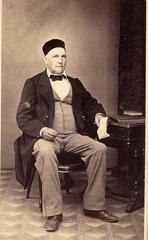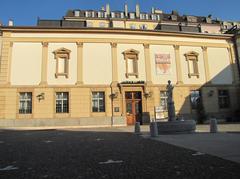
Prison Tower Neuchâtel: Visiting Hours, Tickets, and Travel Guide
Date: 03/07/2025
Introduction to the Prison Tower and Former Prison in Neuchâtel
Perched atop a commanding hill overlooking Lake Neuchâtel, the Prison Tower (Tour des Prisons) and the Former Prison are enduring symbols of the city’s medieval origins, judicial evolution, and cultural transformation. Dating back to the 10th century, these landmarks originally formed part of Neuchâtel’s fortifications before becoming central to its justice system. Today, they stand as powerful reminders of the region’s history, architectural resilience, and ongoing cultural renaissance.
Notably, the Prison Tower and Former Prison are being revitalized as “La Tour du Fantastique,” a cultural hub celebrating fantasy art, spearheaded by renowned illustrator John Howe and integrated with the Neuchâtel International Fantastic Film Festival (NIFFF). This guide offers comprehensive information for visitors: from historical context and architectural features to practical details about visiting hours, ticketing, accessibility, guided tours, and travel tips. Whether you are drawn by medieval intrigue, panoramic Alpine views, or contemporary creative energy, the Prison Tower and Former Prison promise a rich, immersive experience (Neuchâtel Tourism, MySwitzerland, Journal N°, 2023).
Table of Contents
- Introduction to the Prison Tower and Former Prison in Neuchâtel
- Medieval Origins and Strategic Purpose
- Transition to Penal Use
- Architectural Evolution and Restoration
- Role in Neuchâtel’s Judicial and Social History
- Urban Significance and Preservation
- Visitor Experience: Exhibitions and Interpretation
- Visiting Hours, Tickets, and Travel Tips
- Guided Tours, Special Events, and Accessibility
- How to Get There and Nearby Attractions
- Frequently Asked Questions (FAQ)
- Vision for a Cultural Renaissance: The Prison Tower and Former Prison Complex
- Enhance Your Visit with Audiala
- References and Further Reading
Medieval Origins and Strategic Purpose
The Prison Tower and Former Prison are integral to Neuchâtel’s medieval fortifications. The earliest mentions of the site date back to 1011, when Rudolf III of Burgundy granted the “novum castellum” (new castle) to his wife—likely encompassing what would become the Prison Tower (myswitzerland.com). Built in the late 12th or early 13th century with thick yellow sandstone walls, the cylindrical tower was designed to repel invaders and provide a vantage point over the city and lake.
Strategically positioned to control access and oversee vital trade routes, the tower was a critical element in the city’s defensive ensemble, alongside Neuchâtel Castle and the Collegiate Church. Its Romanesque military architecture emphasized durability and function, with minimal ornamentation and narrow windows.
Transition to Penal Use
As military threats waned by the late Middle Ages, the Prison Tower’s role shifted from defense to incarceration—a common trend across Europe. The structure was adapted to house criminals, debtors, and political prisoners, while the adjacent Former Prison was added in later centuries to accommodate growing judicial needs.
By the 16th century, this site was Neuchâtel’s primary detention center, characterized by cramped, dimly lit cells and austere conditions typical of the era’s penal philosophy.
Architectural Evolution and Restoration
Throughout its history, the Prison Tower underwent expansions—reinforced upper levels, added floors, and integration with the Former Prison, which incorporated Renaissance and later influences. Despite these changes, much of the medieval core remains intact, offering a rare glimpse into historical construction techniques.
Significant restoration efforts in the 19th and 20th centuries preserved the integrity of the site while adapting it for modern visitors. After a fire in 2015, further repairs were initiated, with current redevelopment projects aiming to restore and repurpose the complex as a major cultural venue (notrehistoire.ch, J3L).
Role in Neuchâtel’s Judicial and Social History
For centuries, the Prison Tower and Former Prison were central to Neuchâtel’s legal and penal systems. The complex hosted trials, detentions, and, at times, executions. It was the site of incarceration for various individuals, from petty thieves to political dissidents, especially during periods of religious and political upheaval such as the Reformation and the republican revolution of 1848.
By the 19th century, penal reforms led to improved conditions and the eventual closure of the prison, with inmates transferred to modern facilities. The site has since been preserved as a monument to Neuchâtel’s evolving approach to justice and governance.
Urban Significance and Preservation
Situated above the old town, the Prison Tower and Former Prison dominate Neuchâtel’s skyline and serve as a visual anchor for the city’s medieval heart. Their preservation underscores Neuchâtel’s commitment to cultural heritage, drawing thousands of visitors annually and contributing to the city’s vibrant historical landscape (Neuchâtel tourism).
Visitor Experience: Exhibitions and Interpretation
Visitors can explore restored prison cells, guardrooms, and administrative spaces, many preserved in their historical state. Guided tours—available in multiple languages—feature interpretive panels and multimedia displays, deepening understanding of medieval penal practices and the site’s broader historical context.
Special exhibitions often focus on notable inmates or pivotal moments, such as the Reformation or Napoleonic era, while educational workshops and cultural events highlight themes of justice and human rights.
Visiting Hours, Tickets, and Travel Tips
- Location: Rue J. de Hochberg 5, 2000 Neuchâtel; accessible on foot from the train station in about 15 minutes through the old town’s pedestrian zone (Yelp).
- Opening Hours: April to October, Tuesday to Sunday, 10:00 AM – 5:00 PM. Closed Mondays and public holidays. Always check the official tourism website for current hours and any temporary closures.
- Tickets: CHF 8 for adults, CHF 5 for students and seniors, free for children under 12. Family and group discounts available. Tickets can be purchased online or at the entrance.
- Accessibility: Due to historic architecture, the site has limited wheelchair access. Some areas feature narrow stairs and uneven floors. Contact the visitor center in advance for specific accessibility needs or to inquire about alternative virtual tours.
- Best Time to Visit: Weekday mornings or late afternoons are quieter. Spring and autumn provide pleasant weather and excellent light for photography.
- Photography: Permitted without flash or tripods. The panoramic terrace offers stunning views of Lake Neuchâtel and the Alps.
Guided Tours, Special Events, and Accessibility
- Guided Tours: Offered daily at 11:00 AM and 3:00 PM in several languages. Audio guides are also available for self-paced exploration.
- Special Events: The tower hosts medieval reenactments, lectures, workshops, and cultural festivals, particularly around March 1st (Neuchâtel’s cantonal holiday) and during the NIFFF.
- Educational Programs: School workshops and educational tours engage younger visitors.
- Accessibility: While some upper levels remain challenging, ramps and elevators are being introduced as part of ongoing redevelopment, with universal access a key goal for the future.
How to Get There and Nearby Attractions
- Getting There: The Prison Tower is centrally located and easily reached by public transport or on foot. The old town is Switzerland’s largest pedestrian zone, making it ideal for walking tours.
- Nearby Attractions:
- Neuchâtel Castle: Offers guided tours and exhibitions (explorial.com).
- Collegiate Church: A masterpiece of Romanesque-Gothic architecture.
- Old Town: Characterized by yellow sandstone buildings, lively squares, and local cafes.
- Laténium Archaeology Museum: Showcasing prehistoric finds.
- Neuchâtel Art & History Museum: For deeper dives into local culture (switzerlanding.com).
Frequently Asked Questions (FAQ)
Q: What are the Prison Tower Neuchâtel visiting hours?
A: Tuesday to Sunday, 10:00 AM to 5:00 PM (April–October). Always check the official website for updates.
Q: How much do tickets cost?
A: CHF 8 for adults, CHF 5 for students/seniors, free for children under 12.
Q: Is the Prison Tower accessible for people with limited mobility?
A: Accessibility is improving but remains limited in some areas due to historic constraints. Contact ahead for assistance.
Q: Are guided tours available?
A: Yes, daily tours at 11:00 AM and 3:00 PM; audio guides also offered.
Q: Can I take photos inside?
A: Yes, photography is allowed except with flash or tripods.
Q: What are the best times to visit?
A: Weekday mornings or late afternoons for fewer crowds and the best lighting.
Vision for a Cultural Renaissance: The Prison Tower and Former Prison Complex
Strategic Reimagining: From Historic Landmark to Cultural Epicenter
A bold redevelopment—backed by the City and Canton of Neuchâtel, the NIFFF, and John Howe—is transforming the Prison Tower and Former Prison into “La Tour du Fantastique,” a dynamic cultural center (Journal N°, 2023).
Restoration and Modernization
- Post-fire Restoration: Efforts after the 2015 fire focus on structural repairs and accessibility enhancements (J3L).
- Pedestrian Bridge: A new link between tower and prison building allows universal access.
- Revitalized Terrace: The panoramic terrace will feature a café and gathering space.
New Cultural Spaces
- Exhibition Halls: Three levels dedicated to fantasy art, with permanent and temporary exhibitions inspired by John Howe (Journal N°, 2023).
- Creative Workshops: The top floor will host interactive events and artist meet-and-greets.
- Preserved Prison Cells: Offering authentic insight into the site’s layered history.
Thematic Focus and Community Engagement
- Showcasing Fantasy Art: John Howe’s legacy and creative process take center stage.
- NIFFF Collaboration: The site will serve as a hub for the Neuchâtel International Fantastic Film Festival.
- Living Traditions: Community spaces for participatory art projects and educational programming (lebendige-traditionen.ch).
Integration with Urban and Cultural Strategy
Aligned with Neuchâtel’s 2040 plan, the project emphasizes sustainable mobility, economic growth, and quality of life enhancements (Projet de territoire, 2023).
Practical Information for 2025 and Beyond
- Opening Hours: Anticipated Tuesday to Sunday, 10:00 AM – 6:00 PM (seasonal variations possible).
- Tickets: Approx. CHF 12 for adults, with concessions.
- Accessibility: Elevators, ramps, and accessible restrooms throughout.
- Location: Rue Jehanne de Hochberg 5; easy access by public transport.
Enhance Your Visit with Audiala
For expert audio guides, interactive maps, and the latest updates on events and exhibitions, download the Audiala app. Stay connected on social media and explore related posts to enrich your discovery of Neuchâtel’s unique heritage.
Summary and Visitor Tips
The Prison Tower and Former Prison in Neuchâtel capture the city’s layered past—spanning medieval defense, judicial history, and a bold leap into contemporary culture. The ongoing transformation into “La Tour du Fantastique” will further elevate the site, blending heritage with innovation. With original cells, panoramic views, guided tours, and vibrant programming, the complex offers a multifaceted experience for all visitors.
Plan ahead by checking official resources for up-to-date visiting hours, ticket prices, and special events. Use the Audiala app for enhanced tours and insider tips. Whether you are passionate about history, architecture, or the arts, the Prison Tower stands as a must-see destination in Switzerland (Neuchâtel Tourism, J3L, Journal N°, 2023).
References and Further Reading
- Neuchâtel Tourism
- MySwitzerland: Neuchâtel Old Town
- J3L: Prison Tower Neuchâtel
- Journal N°, 2023
- Neuchâtel 2040 Territorial Project
- Cultural Traditions in Neuchâtel
- Yelp: Prison Tower Neuchâtel
- Explorial: Neuchâtel Castle
- Switzerlanding: Things to Do in Neuchâtel
- notrehistoire.ch: Prison Tower History


